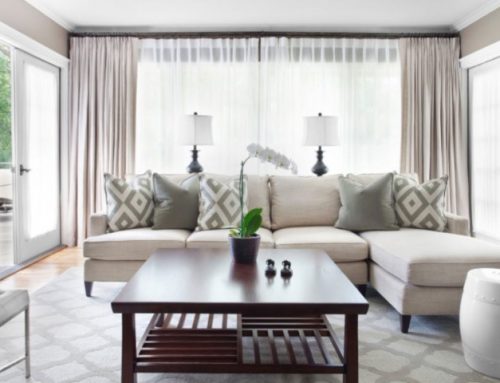The term valance refers to any type of drapery to hide the top portion of the curtains. But that definition is exactly like the role that valances play.
They may look simple, but they serve a very important role in home décor.
They accentuate the overall window architecture and introduce a unique fluidity in home décor.
In simple words, if you want to improve your home’s aesthetic appeal, this is the easiest option.
In fact, valances take your window décor to the next level.
The wide range of designs, colours and patterns bring in variety and cheerfulness to your home décor.
Valances are versatile as well. They can be used almost in any corner of the house from living room to kitchen and bathrooms.
In fact, there are many types of valances that you can choose from. Each serves a specific purpose.
1. Cascade
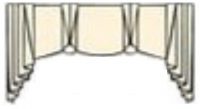
As the name describes this curtain valace style, there is a cascading effect. It provides a soft center of attention.
- You can create cascades with an equal number of pleats or in a staggered manner.
- In the latter, the pleat lengths differ from one another.
- The pattern of the individual cascade will depend on the pleating style you chose.
- The ends normally taper like a tail with swags in between.
- The length of the swags and tails depend on the window height and the curtain design. But as rule of thumb, the tail is 2-3x longer than the individual swags.
Additionally, they also bring in a seamless fluidity.
2. Scalloped Pinched Bells

The name is self-explanatory.
- The bottom half of these valances are scalloped.
- In between the cascades, you have small pleats with pinched tops.
- These give the appearance of bells alternating the scalloped cascades.
They are ornate and make your windows appear extremely dressy. These are best suited for tall windows or big doors.
You can incorporate this style using a wide range of materials from satin to silk and cotton to crepe.
3. Scalloped Pinched Bells Top

These look similar to the scalloped pinched bells, but there is a slight difference.
- The top is not as closely pleated as the pinched bells.
- You can hang these types of valances through a rod, rings or even a wooden board.
- They have an inherent decorative feel to the entire window décor.
These are classic design styles that offer a festive look to your house.
But you must remember that these use up a large amount of fabric and require absolute precision.
The pinched bells top need to be equal for the best impact.
4. Scalloped Ties

Yet again, this is explanatory valance style.
Here the individual cascades are pinched together in the form of small ties.
Again, an ideal example of faultless finishing and eye for details, it is an eye-catching variation.
- You can use these valances to create a contrast.
- These can also work conveniently to accentuate the architectural brilliance of your windows.
- They work effectively in light materials with floral or other trendy prints.
These are also very versatile and work well in somber as well as casual settings.
5. Imperial W/Stacked Jabots

A jabot is primarily a stationary panel. It is used alternatively with the swags as you see in scalloped valances.
- The cardinal feature of Imperial valances is the flat curves that are framed by the stacked jabots.
- They use a lot less amount of fabric and offer understated elegance.
- The subtlety in these valances is quite striking.
- This is a traditional valance style and works equally well for small and large windows.
The imperial valances have a classic touch and reminiscent of the vintage glory. They are very effective in concealing ugly curtain ends.
6. Bordeaux
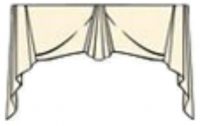
This one is relatively less elaborate and dressy, but that does not make it any less elegant.
- This drapery style has a soft and subtle charm.
- The simplicity of it makes it ideal for all types of rooms.
- The swags and tails, in this case, are relatively less structured.
- They are not as uniform and explicit as you see in scalloped valances.
Moreover, it is a more affordable design as well. The lesser number of swags needs lesser fabric.
From the study to the master bathroom, you can use them in all types of rooms.
These bring about a sense of serenity. Even in terms of fabric, you can represent this design on a large range.
7. Summerhouse
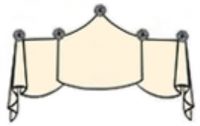
This is a relatively casual valance design.
The corners are not pleated in a rigid fashion, nor are the bottoms rounded off in perfect circles.
As a result, this instantly brings about a casual and contemporary feel to your room.
Perhaps, this is the reason that the Summerhouse is so popular at spas.
- The effortless fluidity and the soft pastel colors usher in the sense of calm and comfort.
- The pastel shades lend vibrancy to the room
- These can be easily hung on rods and maintenance is also extremely hassle-free.
It puts you at ease instantly. As a result, you can easily wash these and hang it back the same day, in a matter of hours.
It also allows the passage of natural light very well.
8. Louis XV

The very mention of Louis XV emanates a sense of regal grandeur. Quite in keeping with the royal charm of the name, this is one of the antique valance patterns. You can normally use a combination of materials and colours.
- The top layer is generally more dressy and striking
- The curtains are subtle in both colour and choice of fabric.
- Though the swags and tails are not very elaborate, they are uniform.
- There is a specific structure and similarity in the overall pleating.
- The tails, in this case, tend to be longer than the broad swags.
9. Charleston

This valance pattern in relatively simpler and somewhat similar to the Bordeaux.
- But the Charleston Valance will have pipes instead of pleats.
- The term pipe refers to early 20th-century window treatment
It exudes antique glory in its simplicity. Most fabrics work very well in this case but remember to avoid stiff or bulky trims.
10. Morland

This valance design was inspired by FA Moreland, one of the masters of the 19th-century designer drapery.
- In this one end drapes rather long and the pleat is tapered deeply.
- The other end is comparatively shorter and hardly has two shallow pleats.
- The rosette at the corner gives the appearance that the valance is tied to the pole.
- Ideally, soft fabrics work best for this particular patterns
This particular style is well suited for a girl’s room. Rather it gives any room a feminine touch.
11. Karmen
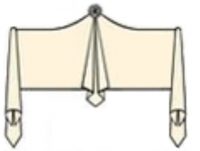
This is another classic valance pattern that has seamlessly transitioned into a contemporary style.
- This draping style is relatively minimalist in approach
- But it needs a greater degree of precision.
- The seams also tend to be rather elaborate in this design style
As a result, the Karmen can easily transform any window into a vibrant and bright center of attraction.
It works quite effectively in living rooms, master bedrooms and guest rooms.
12. Buttons and Bells

This is one of the most striking examples of the gently sewn combination of glamour and subtlety.
- These valance patterns look best in relatively heavy fabric
- This is because the pleats are visible in a more striking manner
As the name indicates, there is small bell-shaped pleated alternating with simple swags. The bell-shaped pleats are held together by the buttoned tops.
13. Shaped Flat

Generally, these valances cover the topmost part of the window.
They can hang on their own or with curtains or blinds.
- Often these valances are created to cover the window frame and make it interesting.
- In fact, this is one of the best options to hide ugly curtain rods and other drapery accessories.
- These valances are also effective in areas where the overall floor space is limited.
You can match these with the fabric used for upholstering recliners and couches in the room.
This will help create a seamless continuity in your home décor.
Imagine your kitchen window, and you can instantly relate to this valance pattern.
It is simple yet striking, uncomplicated and contemporary.
14. Soft Dip
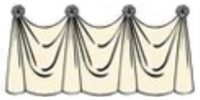
Imagine dressing up a really plain and regular window and transforming it into something magical.
Well, that is exactly what this valance pattern strives to achieve.
Whether it is your kitchen or the children’s study, it can be a great style to dress up the windows.
For example, if you are using it in a kitchen window with predominantly white décor, go for bright, bold colours.
You can also choose some elaborate print.
- Bold prints, striking colours and appropriate fabric make the best impact.
- These valances can hang on rods or rings and make a strong statement.
15. Inverted Box
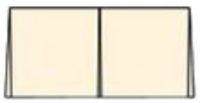
This is one of the most classic and versatile valance patterns.
You can use it for formal and casual décor depending on the fabric.
Lightweight or medium weight materials are best suited for this valance style.
There is a rustic simplicity in this valance pattern but at the same time,
- It represents precision.
- It lends any room a bit of masculine or gender-neutral feel.
- Family rooms, master bedrooms and guest rooms are well suited for this pattern.
16. Soft Dip W/Cuff

They are cute, slender and sleek. Elegance is its middle name and it attracts attention to any window where it is used.
- These valances are mostly scalloped at the edges.
- They can be easily adapted to any type of window size.
- These are most commonly found in kitchens and used to cover ugly drapery accessories.
- Teaming the right fabric, print and colour combination is the key challenge in this valance pattern.
- Do not use a very heavy material for it. Soft, light-weight fabrics are best suited for this pattern.
It highlights the subtle scallops beautifully and lends a fluid momentum to the home décor.
17. Carolina

If you want to introduce a bit of French luxury and style in your home décor, you can choose this pattern for your window valances.
They are relatively elaborate and comprise of alternate swags and pipes.
The seams of these types of drapes need special mention.
You can easily make them very striking by introducing decorative elements like ruffles and frills.
- These valances offer a festive and formal look to your space
- Fringes too can work quite effectively with this valance pattern.
- It is a great option to dress up rather unassuming windows.
- However, you cannot use very light material for these valances.
- Medium to the heavy-weight material can be pleated most appropriately in this pattern.
18. Morracon

As the name indicates, it is all about creating an exotic Moroccan feel in your house.
This valance pattern in many ways looks similar to Karmen.
But here the patterns are a lot more elaborate.
- The pleats are not as structured as you see in other classic valance designs.
- The Morocco-inspired geometric designs is another key element in this valance style.
- You can either use it as a standalone window décor or along with blinds or curtains.
- These can be easily hung on rods and help in hiding drapery accessories that might be jutting out.
- Avoid cumbersome materials for this valance style.
19. Delaine

If you have a really long window stretching across a wall, this can be a fascinating and striking option.
This is a combination of full lines and interlined valances.
- You can either hang them with a rod or even use rings
- They hang like festoons and are ideal for morning rooms.
- They accentuate the natural light that’s coming in
- They make the rooms appear more spacious.
Conclusion
The various types of valances often represent the gradual evolution of home décor styles.
They help dress up windows, enhance the beauty of your rooms and a practical way to cover ugly drapery ends jutting out.
In fact, these valances offer one of the most striking combinations of style and functionality.
Interior designers often use the various types of valances to create a unique statement. It lends every room a distinct personality.
You Might Also Like:
1) Choosing Between Curtains and Blinds
2) 20 Ideas for Standout Curtains and Blinds
3) 12 Common Types of Curtains
4) 10 Different Types of Blinds



